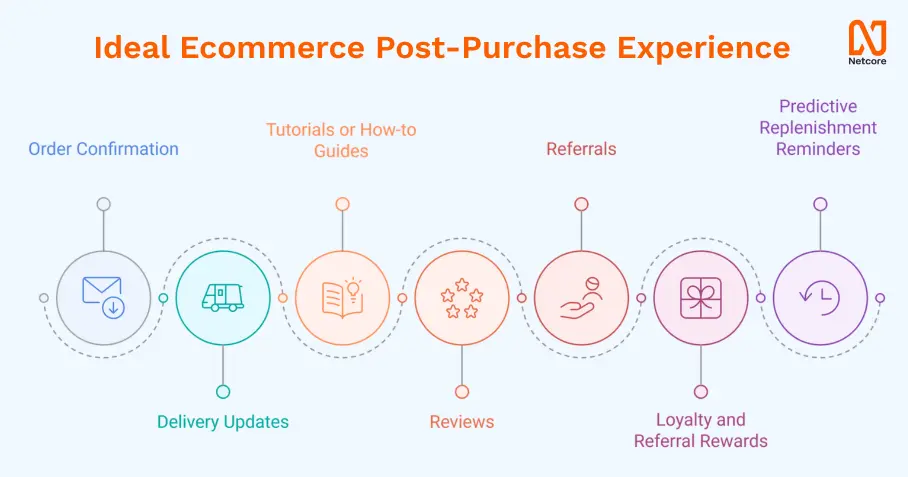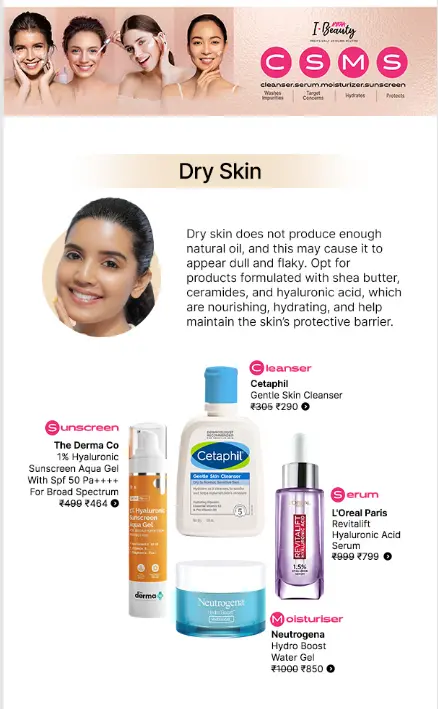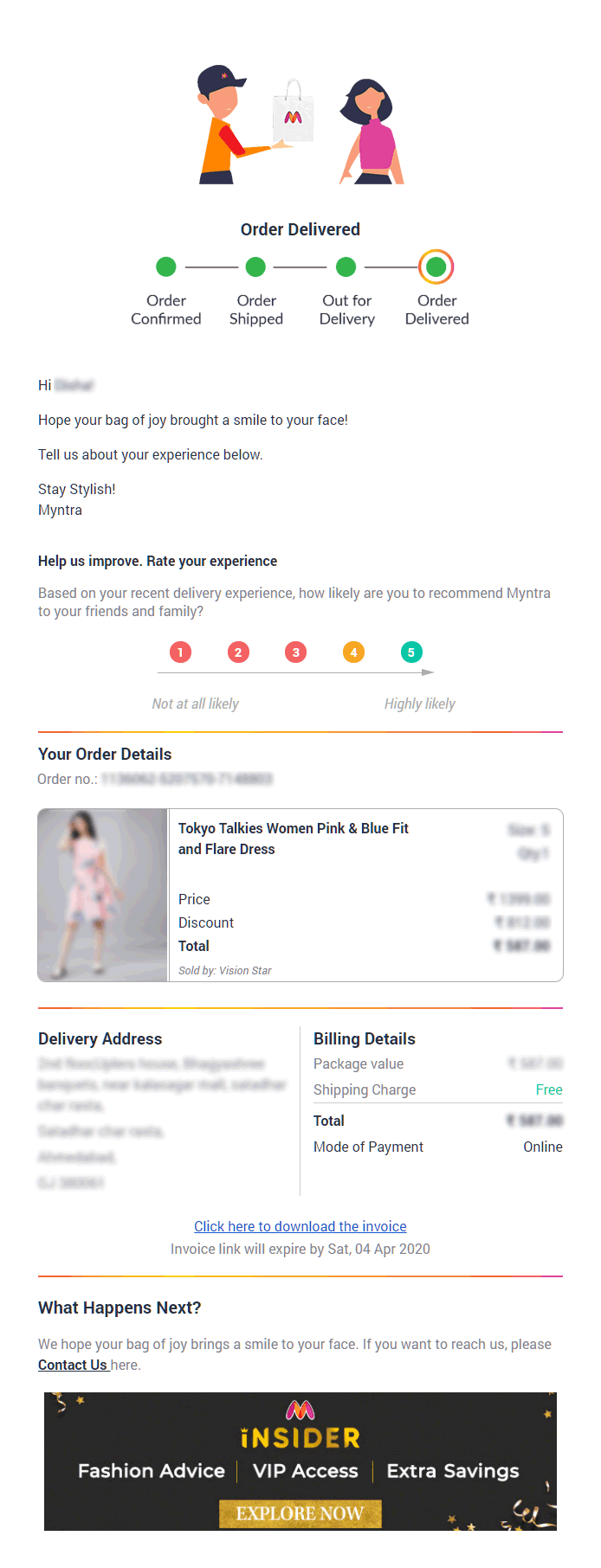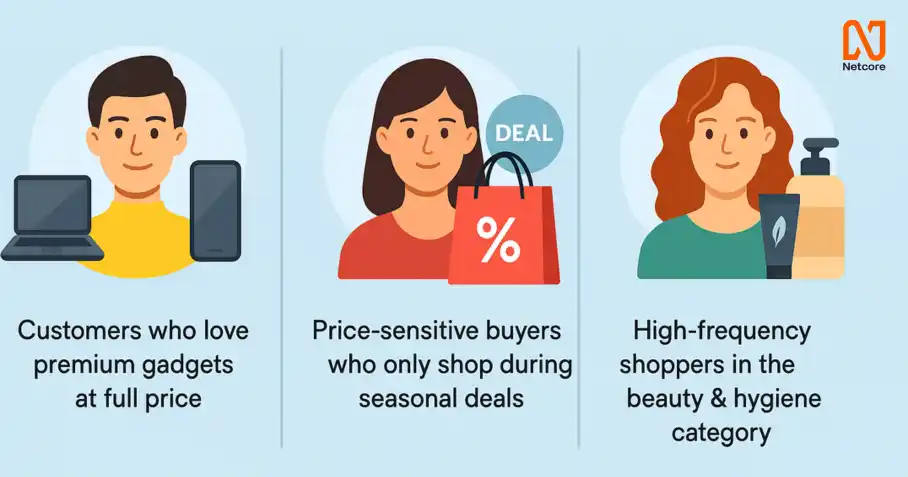The sale isn’t the finish line—it’s the starting point of a profitable customer relationship.
For years, ecommerce marketers in India and APAC focused their budgets on acquisition. Flash sales. Mega campaigns. Influencer drops. But now, customer acquisition costs have skyrocketed, and retention—not reach—is driving growth.
The smartest brands have realized that the post-purchase experience—those touchpoints after checkout—can make or break repeat sales. Add ecommerce automation to that, and you’ve got a 24/7 engagement engine that boosts revenue without increasing headcount.
In this article, I’ll break down 12 post-purchase journeys that turn one-time shoppers into long-term loyalists. From upsells and tutorials to reactivation and loyalty, these are the building blocks of a scalable, AI-powered retention strategy.
What Is an Ecommerce Post Purchase Experience?
It’s everything your customer sees, feels, and experiences after hitting “Buy Now.”
The ecommerce post-purchase experience covers every brand interaction that happens after checkout—order confirmations, delivery updates, tutorials, reviews, referrals, and beyond. It’s where trust is built (or broken).

And automation makes it scalable. Through ecommerce automation, brands can deliver:
- Real-time order updates through email, SMS, or WhatsApp
- Personalized onboarding and how-to guides
- Loyalty and referral rewards based on customer behavior
- Predictive replenishment reminders or cross-sells
In short, post-purchase isn’t about sending one “thank you” email—it’s a connected journey that nurtures customers from “purchased” to “preferred.”
Why Post-Purchase Is the Core of Retention Marketing
Retention is the new acquisition, and automation is how you scale it profitably.
Customer acquisition costs in ecommerce have risen by over 50% in the past five years. But repeat customers? They spend 3–5x more, convert faster, and are far cheaper to retain.
Here’s why the post-purchase stage matters:
- It’s when customer anxiety peaks (“Where’s my order?”).
- It’s your first chance to turn satisfaction into loyalty.
- It’s where you can educate, upsell, and build advocacy.
Think of how Nykaa follows up with personalized skincare routines after a purchase, or Flipkart’s proactive WhatsApp delivery alerts. These aren’t random messages—they’re part of an automated lifecycle built through smart ecommerce automation.


How Automated Post-Purchase Support Builds Loyalty
Support is no longer reactive—it’s predictive, proactive, and personalized.
The days of “contact support if you face issues” are gone. Brands that thrive use automated post-purchase support powered by AI and automation to keep customers informed, reassured, and delighted.
Here’s how it looks in action:
- Order visibility: Real-time updates through WhatsApp and push notifications.
- Returns made easy: Automated workflows for refunds or replacements.
- Proactive help: Triggered messages when customers encounter checkout or delivery issues.
Take Myntra—it uses automated tracking and return alerts to reduce customer friction. Each message is personalized by product, delivery zone, and timing.
Automation turns reactive support into proactive care—and that builds loyalty before customers even think of leaving.

12 Automated Post-Purchase Journeys Every Ecommerce Brand Should Master
Let’s be honest — the moment your customer clicks “Buy Now” is just the beginning.
That’s where the real relationship starts.
A well-designed post-purchase journey doesn’t just reassure—it builds trust, anticipation, and advocacy.
The most successful ecommerce brands today use ecommerce automation to power these micro-moments — turning one-time transactions into long-term loyalty loops.
Here are 12 post-purchase journeys that combine empathy, timing, and automation to deliver truly exceptional ecommerce post purchase experiences.
1. Order Confirmation & Tracking Journeys: Reassure Instantly, Update Frequently
The post-purchase anxiety is real. Your customer has paid, but until that order lands at their doorstep, they’re constantly wondering, “Where is it now?”
That’s why the first automated journey you set up should be your order confirmation and tracking flow. Send an instant confirmation email or WhatsApp message, followed by proactive tracking updates at every stage—“Packed,” “Shipped,” “Out for delivery,” and finally, “Delivered.”
Example: Flipkart does this brilliantly. Their WhatsApp “Track your package” alerts not only offer real-time delivery updates but also feature smart cross-sell banners (“Pair it with this case” or “Try this accessory”).
💡 Pro tip: Add extra value by including care instructions, FAQs, or return policies within the same thread—reducing post-purchase uncertainty while subtly reinforcing brand trust.
2. Product Education & How-To Journeys: Educate Before Problems Arise
Few things erode trust faster than confusion. When customers don’t know how to use what they bought, returns skyrocket.
That’s where product education journeys step in. Use automation to deliver setup guides, video tutorials, or how-to content immediately after delivery.
Example: Boat uses short, snappy setup videos to show customers how to pair their headphones or maintain their sound gear. This simple, automated flow has drastically cut down support tickets and return rates.
When customers succeed with your product quickly, satisfaction grows—and so does lifetime value.
3. Cross-Sell & Upsell Journeys: Personalize Through Behavior, Not Guesswork
A great post-purchase journey doesn’t just end with “thank you.” It anticipates what’s next.
With ecommerce automation, you can analyze customer behavior and recommend complementary or upgraded products at just the right moment.

Example: Apple’s iconic “Complete your setup” emails or Tira’s “Pair your purchase” recommendations are perfect examples. A customer who just bought lipstick might be nudged toward a matching liner, while someone who bought a smartwatch might get accessory suggestions.
💡 Pro tip: The key is subtlety—personalized recommendations should feel like help, not a sales pitch.
4. Review & Feedback Journeys: Automate Your Reputation
Customer reviews are the social proof your future buyers depend on. But asking for them manually? That’s inefficient—and inconsistent.
Automate review and feedback journeys to trigger a personalized message right after delivery.
Example: Nykaa does this flawlessly. Their timed WhatsApp and email prompts—sent just when customers are most satisfied—generate thousands of authentic product reviews every week.
Each automated feedback request not only boosts credibility but also signals care: “We value your opinion.”
5. Replenishment Journeys: Anticipate Needs Before They Arise
Imagine this: a customer runs out of their favorite skincare serum, but before they even think to reorder, your brand pings them with a friendly reminder. That’s the magic of replenishment automation.
Example: BigBasket nails this with predictive replenishment journeys. Based on buying frequency and category data, it automatically reminds users to restock essentials—milk, rice, detergent—just before they run out.
For FMCG and consumable products, this is one of the highest ROI automation flows you can set up.
6. Loyalty & Rewards Journeys: Reward Actions, Not Just Transactions
A loyalty program is only as strong as its visibility. If customers don’t know they’re earning rewards, the incentive loses meaning.
Automate loyalty and rewards journeys to remind customers of their progress and upcoming perks.
Example: Tanishq’s loyalty communications—sent through WhatsApp and email—highlight reward milestones, upcoming offers, and bonus-point opportunities, creating a sense of momentum and exclusivity.
💡 Pro tip: Add emotional storytelling—“You’ve been with us for a year!”—to make the journey feel human, not mechanical.

7. Referral & Advocacy Journeys: Turn Happy Customers Into Advocates
Your happiest customers are your best marketers. But they won’t share unless you ask them at the right time—when excitement peaks.
Automate referral journeys to trigger just after a positive review or delivery confirmation.
Example: Meesho activates its “Refer & Earn” journey right after a successful order delivery. The timing is perfect—customers just had a good experience, and sharing feels natural.
The result? Viral growth that costs less than traditional advertising.
8. Win-Back & Reactivation Journeys: Bring Back the Silent Majority
Even the best brands lose customers to silence. But instead of letting dormant shoppers drift away, use automation to re-engage them.
Trigger personalized reactivation campaigns after 30–60 days of inactivity. Tailor your offers based on past purchases or browsing behavior.
Example: Myntra’s “We miss you” emails combine nostalgia (“Remember your last purchase?”) with urgency (“Your favorites are back—with 15% off!”).
💡 Pro tip: Use AI to identify why customers disengaged—price, timing, or preference—and personalize your comeback accordingly.
9. Birthday & Anniversary Journeys: Add Emotion to Automation
Emotional connection beats transactional loyalty every time.
That’s why birthday and anniversary journeys are gold. They show customers you remember them—not just their wallet.

Example: Starbucks India automates birthday offers through its mobile app—free drinks, exclusive coupons, or bonus points. These small touches strengthen emotional affinity and boost visit frequency.
Automation here isn’t cold—it’s thoughtful at scale.
10. Community & Content Journeys: Build Beyond Transactions
Your post-purchase relationship shouldn’t end with “thank you for shopping.” Customers today crave connection, not just consumption.
Community and content journeys help you build that.
Example: Decathlon sends automated “Get more out of your gear” emails after purchases—featuring training videos, fitness challenges, or product care tips. It keeps customers inspired and engaged long after the sale.
💡 Pro tip: Mix content formats—stories, user-generated content, or tutorials—to deepen brand connection.
11. Sustainability & Brand Value Journeys: Reinforce What You Stand For
Consumers want to align with brands that share their values. The post-purchase stage is the perfect moment to reinforce that alignment.
Example: Bewakoof’s “Recycle with us” campaign invites customers to send back old clothes for recycling. Automated messages guide them through the process and reward participation with loyalty points.
It’s more than a marketing journey—it’s a brand story told through automation.
12. Churn Prevention Journeys: Predict Disengagement Before It Happens
The best retention strategy is one that prevents churn before it starts.
AI-driven churn prevention journeys use behavioral signals—reduced site visits, smaller basket sizes, lower email engagement—to trigger early interventions.
Example: Netcore Cloud’s Segment Agent detects customers at risk of churn and automatically triggers personalized retention messages—discounts, reminders, or reactivation nudges—in real time.
This isn’t reactive marketing. It’s predictive engagement, powered by automation that learns continuously.

Bringing It All Together
Each of these journeys serves a purpose—reassure, educate, re-engage, or delight.
But the real power lies in how they connect.
When orchestrated through intelligent ecommerce automation, they form a self-sustaining post-purchase ecosystem—one that reduces churn, increases lifetime value, and keeps customers emotionally invested in your brand.
Because in 2025, great ecommerce marketing won’t be about chasing the next sale.
It’ll be about building continuous conversations—and letting your automation do the heavy lifting while your brand earns the loyalty.
The Core Components of a Smart Post-Purchase Automation Framework
Personalization + timing + data = retention at scale.
To deliver a world-class ecommerce post purchase experience, brands must integrate:
1. Unified customer data: Connect CRM, website, and app activity.
2. Behavioral triggers: Launch journeys based on real actions, not assumptions.
3. Dynamic content personalization: Use AI to tailor messages by product, segment, and channel.
4. Omnichannel orchestration: Coordinate across email, push, WhatsApp, and SMS.
5. Continuous optimization: Analyze engagement and refine messaging.
Real-Life Ecommerce Automation Examples Driving Loyalty
Here’s how leading Indian and APAC brands are already winning with automation:
- Nykaa: Automated skincare tutorials and reorder reminders.
- Myntra: Dynamic segmentation for churn prevention.
- BigBasket: Smart replenishment reminders based on order frequency.
- Tira: Cross-sell and loyalty automation.
- Amazon India: Predictive recommendation loops for next-best purchases.
Each of these uses ecommerce automation to scale engagement with human-like precision.
How AI Elevates the Ecommerce Post Purchase Experience
Automation makes engagement faster; AI makes it smarter.
AI-led ecommerce automation platforms like Netcore Cloud bring agentic intelligence to post-purchase journeys.
- Predictive Replenishment: AI forecasts when a customer is likely to reorder.
- Smart Segmentation: Dynamic segments update in real time based on browsing or purchase behavior.
- Personalized Messaging: The right message, at the right time, through the right channel.
Netcore Cloud’s AI Agents—Segment Agent, Content Agent, and Insights Agent—work together to create a continuously learning, self-optimizing post-purchase ecosystem.
Instead of sending campaigns manually, your AI can:
- Identify at-risk customers
- Personalize reactivation messages
- Recommend next-best offers automatically
That’s not just automation—that’s Agentic Marketing in action.
How to Build Your Post-Purchase Automation Strategy
Start small. Automate smart. Scale fast.
Here’s a streamlined roadmap to build a high-performing post-purchase automation engine:
1. Define your post-purchase objectives
Decide what outcomes you want — from shipping updates and reviews to repeat purchases or loyalty enrollments.
2. Trigger automated workflows based on transactions
Set event-based automations (e.g., “Product Purchase”) that kick off personalized journeys across email, WhatsApp, and app push.
3. Sequence journey components with smart timing
- Immediately: Send thank-you and order confirmations.
- During delivery: Trigger proactive shipping and delivery updates.
- Post-delivery: Request feedback or NPS to turn buyers into advocates.
- Later: Send retention nudges and cross-sell/upsell offers based on behavior data.
4. Personalize through segmentation
Use advanced segmentation (affinity, CLTV, churn risk) to tailor every message — giving high-value customers loyalty incentives and re-engaging at-risk ones.
5. Orchestrate across multiple channels
Coordinate updates and nudges across email, SMS, push, WhatsApp, or RCS to reach customers where they prefer — consistently, not redundantly.
6. Add interactive, convenience-first features
Enable interactive elements like in-email tracking, quick feedback, or add-to-cart options to simplify engagement and reduce friction.
7. Measure, iterate, and optimize
Track key KPIs (CLTV uplift, repeat purchase rate, engagement metrics) and A/B test timing, copy, and channels to refine performance.
8. Example: Practical Automation Flow
- Trigger: Product purchase
- Immediately: Send order confirmation (email + app push)
- On shipment: Send status updates (SMS/WhatsApp + email)
- On delivery: Send confirmation + review request
- 7–30 days later: Send cross-sell offers or loyalty invites
9. Reinforce retention with incentives
Reward loyalty — offer personalized discounts, exclusive access, or referral rewards to keep customers engaged beyond the sale.
Platforms like Netcore Cloud simplify this entire process — letting you build, deploy, and optimize multi-channel post-purchase journeys without developer dependency.
Conclusion: The Future of Retention Lies in Automation
Retention isn’t a campaign—it’s a continuous conversation.
The future of ecommerce will belong to brands that make post-purchase engagement intelligent, automated, and adaptive.
Whether it’s a how-to video, a replenishment alert, or a churn-prevention nudge, every message counts when it’s powered by ecommerce automation and guided by AI.
As brands across India and APAC embrace Agentic AI systems, the ecommerce post purchase experience will evolve from being reactive to self-optimizing.
So here’s the challenge: stop thinking in campaigns. Start thinking in customer journeys.
Because the next big leap in ecommerce growth doesn’t happen before the sale—it happens after it.











